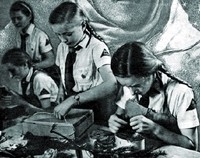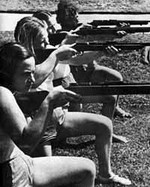 The League of German Girls found itself in a new and different position with the outbreak of World War II in September 1939.
The League of German Girls found itself in a new and different position with the outbreak of World War II in September 1939.
On one hand, the Nazi party now wanted the education of the girls steered more toward traditional roles of women, to be mothers and homemakers, which is a trend that had become more prevalent after the First Hitler Youth Law went into effect at the end of 1936.
Ironically, wartime needs in Germany required women to take job positions both in the civilian life as well as in the armed forces. Women became air raid wardens, military signals auxiliaries and secretaries, but they also served in home front roles such as workers in munitions factories, or as nurses. And, of course, many stayed home, took care of their children while their husbands were away, and supported the troops in whichever ways they were able.
For members of the League of German Girls, the war also changed their schedules. When local groups met now, they often spent their time writing letters to soldiers or making packages for troops at the front. A manual about the wartime work of the Hitler Youth was published, which gave both the male and female Hitler Youth members suggestions and ideas of what they could do to help – for the League of German Girls, those ideas included many knitting patterns to make wool gloves, ear warmers, and socks for the troops, as well as instructions on making straw slippers for wounded soldiers at hospitals, to name a few. BDM choirs and music groups now practiced to perform for wounded soldiers at military hospitals throughout Germany, and often, girls would go to the train station to welcome soldiers coming back from or going off to the front with hot coffee and fresh sandwiches.
Magazines, such as “The German Girl”, now had more adverts for the Red Cross or the Stenographer’s Union to encourage girls to learn more about them, and to help the war effort by choosing a job as a nurse or nurse’s aide, or to join the service as a signals auxiliary. Train station services also became an important part of the BDM’s work, especially as the war would wear on. BDM girls, especially health service girls, would spend time at the train stations to welcome injured soldiers, refugees from other parts of the country, and travelers. They provided them with directions, first aid, and food and drink. The girls were required to wear white aprons and kerchief-style nurse’s caps. (It was once remarked that they needed to cover their hair, so the soup they were ladling out to refugees at the train station would not have girls’ hair in it.)
Most girls in the Jungmaedel and the League of German Girls helped support the war in some shape or another. Some made care packages for the soldiers, others visited wounded troops at hospitals, and the majority helped with work such as collecting money, scrap metal, or clothing for the Winter Relief and similar charities (many of which supported the war effort). The younger girls often also helped with part-time work, such as helping with the fall harvest, such as picking apples or bringing in the hay, or with collecting medicinal herbs.
Older girls, such as the members of the BDM’s Belief and Beauty Society, also often took on full-time jobs such as working in stores or factories to relieve mothers who were on motherhood leave, or workers who’d been drafted into the army. They served as nurses, substitute teachers, or secretaries. Girls could also volunteer for programs outside their own areas, and in some cases, even outside their own country – such as the BDM Eastern Action where girls helped on farms, set up kindergartens, or taught in schools. Most times, girls received no special training for this work and worked in challenging conditions.
 Girls who lived in the larger cities of Germany often became air raid wardens and auxiliary firefighters as the war wore on and Allied air raids on the big cities became more common. By the summer of 1942, air raid warden training became a standard component in the curriculum of the Hitler Youth. Around this time, as well, the League of German Girls started to cease existing in the cities because many girls’ homes had been bombed and family members or friends had been killed. The girls were now busy trying to gather what they had left of their belongings and helping their family pick up the pieces and move to a different location, where they were still likely to get bombed out again. Local schools were often closed now and where classes were held, they were often too large to be controlled by one teacher. Local BDM groups had trouble getting organized or finding places to meet, and groups just slowly ceased to exist.
Girls who lived in the larger cities of Germany often became air raid wardens and auxiliary firefighters as the war wore on and Allied air raids on the big cities became more common. By the summer of 1942, air raid warden training became a standard component in the curriculum of the Hitler Youth. Around this time, as well, the League of German Girls started to cease existing in the cities because many girls’ homes had been bombed and family members or friends had been killed. The girls were now busy trying to gather what they had left of their belongings and helping their family pick up the pieces and move to a different location, where they were still likely to get bombed out again. Local schools were often closed now and where classes were held, they were often too large to be controlled by one teacher. Local BDM groups had trouble getting organized or finding places to meet, and groups just slowly ceased to exist.
The End of the War
 Historians like to ascribe the Hitler Youth as a whole a large role during the fighting at the end of the war and often assume, based on few references, that this included the girls of the League of German Girls.
Historians like to ascribe the Hitler Youth as a whole a large role during the fighting at the end of the war and often assume, based on few references, that this included the girls of the League of German Girls.
In reality, many local BDM groups had ceased to exist by the time the Allies entered Germany, and unlike the male Hitler Youth, which was being called up as part of the Volkssturm, girls of the BDM played a very minor role. Some of them, along with local civilians, would help to fortify towns and dig trenches to repel advancing Allied troops. In a few rare instances, women joined the Volkssturm as well – but they were few and far between – and those who did join the Volkssturm served mainly as cooks and medics: providing hot food, being responsible for the food supplies, and providing first aid. I have only found one reference of a BDM girl being in armed ground combat.
A number of BDM girls – small compared to the overall number of its membership – became flak helpers with the Luftwaffe where they mainly manned searchlights and in some cases anti-aircraft batteries. There are no concrete numbers of the overall total of women who served in this position, but among the 14th Flak Division, which protected Southern Germany, some 3,000 women served as auxiliaries.
In March of 1945, Hitler’s secretary Martin Bormann sent a letter to the Gauleiters of Germany regarding the weapons training of women and girls. In short, the letter started that it would be a good idea for girls and women, particularly those who lived out in the country, to become proficient in the use of a rifle or pistol for self-defense purposes against advancing enemy troops. This was partially fuelled by the horror stories about Russians raping and murdering German women as they advanced on Berlin. The training was supposed to be instructed by members of the local Volkssturm units, but in most regions, training never was organized and conducted because things were too chaotic, and weapons in too short of a supply. A group of approximately 200 BDM leaders from the Berlin area were sent on a two week course to become proficient in weapons, but there are no reports that they ever used that knowledge after their return from the course.
A few girls also joined the Wehrwolf organization, which is now generally referred to as the Nazi guerilla movement. While only about 5000 members strong, Wehrwolf’s ranks included some 500 women, a small percentile of whom were BDM girls. The most notable BDM girl to serve in the Wehrwolf was a young former Gaufuehrerin, Ilse Hirsch, who became part of a Wehrwolf team that parachuted into Belgium behind Allied lines, and then crossed into the city of Aachen on foot where they assassinated the mayor who had been appointed by the Allies.


